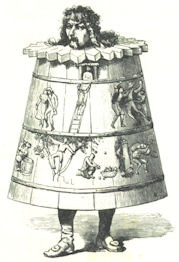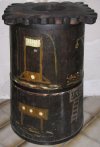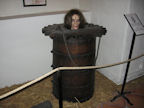



x.jpg)
In 1655, Ralph Gardner wrote that in Newcastle-upon-Tyne, England “he hath seen men drove up and down the streets with a great tub or barrel opened in the sides, with a hole in one end to put through their heads, and so cover their shoulders and bodies, down to the small of their legs, and then close the same, called the new-fangled cloak, and so make them march to the view of all beholders; and this is their punishments for drunkards and the like.”




x.jpg)
Although the Barrel Pillory (also known as "Drunkard’s Cloak" or “The Spanish Mantle”) was by no means universal, there is evidence that it was used sporadically in many European countries, although not necessarily for drunkards. In 1641, the diarist John Evelyn wrote that in Delft, Holland the Senate House contained “a weighty vessel of wood, not unlike a butter churn, which the adventurous woman that hath two husbands at one time is to wear on her shoulders, her head peeping out at the top only, and so led about the town, as a penance for her incontinence”.
